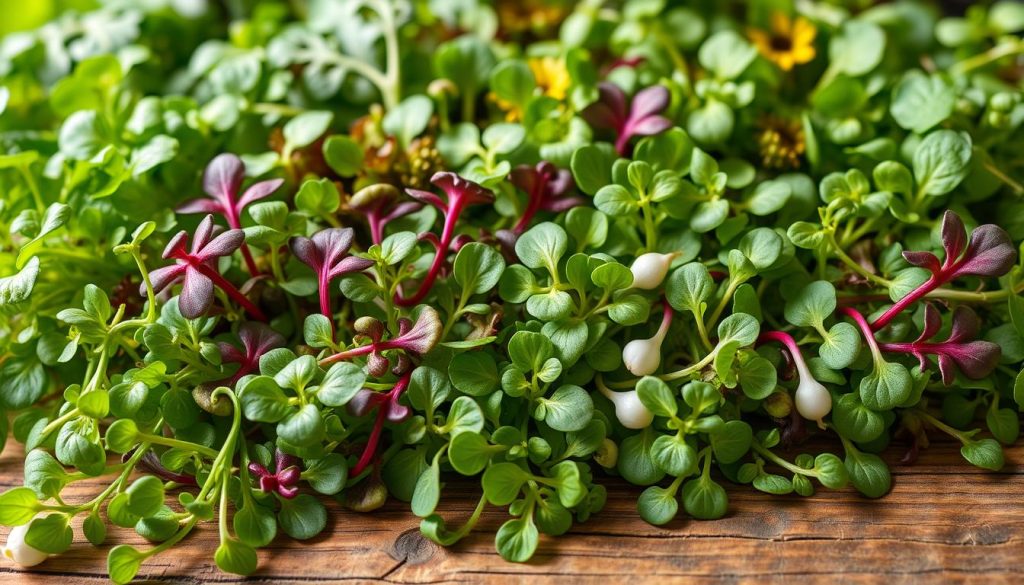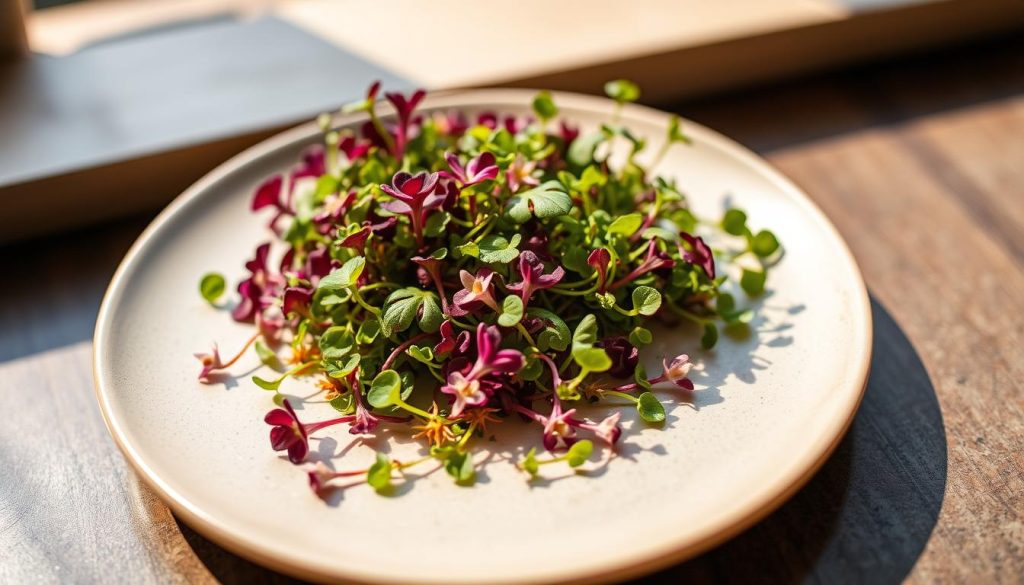Microgreens Culinary Uses: Elevate Your Dishes
Microgreens have changed the way we cook, offering a burst of flavor and health benefits. These small greens add amazing taste and color to many dishes. They turn simple meals into something special.
Top chefs like Dan Barber and Alice Waters love microgreens for their bold taste and flexibility. They use them to add a peppery kick to salads and to make protein dishes even better. This makes microgreens a great choice for both home cooks and professional chefs.
Microgreens are full of nutrients and are at their healthiest when picked young. They have up to 40 times more vitamins and minerals than regular greens. Their fast growth and versatility make them a key ingredient in today’s cooking.
Key Takeaways
- Microgreens deliver concentrated nutrition and flavor
- Versatile ingredients for multiple culinary applications
- Quick to grow and easy to incorporate into dishes
- Enhance visual appeal and taste of meals
- Suitable for various dietary preferences
What Are Microgreens?
Microgreens are tiny, vibrant vegetable seedlings that pack a powerful punch. They are harvested just 7 to 14 days after germination. This gives them an intense burst of flavor and nutrients, making dishes extraordinary.
These small greens are more than just tiny plants. They can have up to 40 times more nutrients than full-grown veggies. This makes them a nutritional powerhouse in the kitchen.
What Exactly Are Microgreens?
Microgreens are not just baby plants. They are a specific category of edible greens harvested early. They are grown in soil or hydroponic mediums and harvested when they’re 2-3 inches tall.
Nutritional Powerhouse
- Rich in essential vitamins and minerals
- Contain higher nutrient concentrations than mature vegetables
- Provide concentrated antioxidants
- Support overall dietary health
Popular Microgreen Varieties
- Broccoli
- Radish
- Arugula
- Kale
- Cilantro
The flavor profiles of microgreens vary widely. They can be peppery and sharp or mild and fresh. Chefs and home cooks love them for adding complex taste to salads, sandwiches, and garnishes.
Growing Considerations
Microgreens can be easily grown in small spaces like kitchen windowsills or balconies. They require minimal equipment and can be harvested quickly. This makes them accessible for urban gardeners and food enthusiasts looking for fresh, nutrient-dense ingredients.
Popular Types of Microgreens
Microgreens have changed the way we cook, offering strong flavors and lots of nutrition in small sizes. With over 1,500 types, they give chefs and home cooks a chance to make their dishes better.

The market for microgreens is worth two billion dollars. This shows how much people love these greens. Chefs and home cooks find them great for adding flavor to their dishes.
Arugula Microgreens
Arugula microgreens add a peppery taste to any dish. They have a strong flavor that makes simple dishes stand out. They’re perfect for:
- Gourmet salads
- Sandwich toppings
- Pizza garnishes
Radish Microgreens
Radish microgreens have a spicy taste and bright colors. Their crunchy texture and sharp flavor are great for:
- Fresh appetizers
- Spicy garnishes
- Raw vegetable platters
Basil Microgreens
Basil microgreens burst with aromatic flavor. Chefs often use them in:
- Italian cuisine
- Pasta dishes
- Fresh summer recipes
Sunflower Microgreens
Sunflower microgreens add a nutty taste to dishes. Their thick texture is perfect for:
- Protein-rich salads
- Smoothie additions
- Nutrient-dense snacks
Trying out different microgreens can make your cooking more exciting. They add depth, nutrition, and fun to every meal.
Enhancing Salads with Microgreens
Microgreens are a game-changer in cooking. They turn simple salads into amazing meals. They add vibrant flavors, textures, and nutrients to your food.
Texture and Flavor Boost
Adding microgreens to your dishes gives them a crunchy texture and bold taste. Each type of microgreen adds its own special touch to salads:
- Pea shoots have a mild, sweet taste
- Radish microgreens add a peppery flavor
- Sunflower microgreens offer a nutty crunch
Pairing Microgreens with Dressings
Choosing the right dressing can make your microgreen salad even better. A simple vinaigrette works well with these greens. Here’s a simple recipe:
- 1/2 cup olive oil
- 1/4 cup rice wine vinegar
- 1 tablespoon Dijon mustard
- 2 teaspoons lemon juice
- Sea salt and black pepper to taste
Creative Salad Combinations
Try mixing different microgreens to make salads that are both beautiful and nutritious. Mixing colors and textures makes for a dish that’s not only tasty but also packed with nutrients.
- Mix green pea shoots with red radish microgreens
- Layer broccoli microgreens with delicate herbs
- Create contrast with different microgreen colors and textures
Microgreens in Soups and Broths
Turning simple soups into gourmet dishes is now easier with microgreens. These tiny greens add nutrition and flavor to your meals. They make your soups look and taste amazing.
Chefs and home cooks are finding new ways to use microgreens in soups. They make ordinary broths into special meals. Microgreens are packed with nutrients, making them more than just a garnish.
Garnishing Techniques
When using microgreens in soups, how you present them is key. Here are some tips:
- Sprinkle delicate microgreens just before serving
- Float tender greens on cream-based soups
- Create artistic patterns with mixed microgreen varieties
Infusing Flavors
Microgreens bring unique flavors to soups. Radish microgreens add a peppery taste, while basil microgreens offer a subtle herbal flavor. Try different types to find new flavors.
Nutritional Enhancements
Adding microgreens to soups can boost their health benefits by 15%. Beet microgreens, for example, have more antioxidants than mature leaves. They’re great for your favorite soups.
Pro tip: Add microgreens in the last 10 minutes of cooking. This keeps their nutrients and colors bright. With just 10 minutes of prep, you can make soups that taste and are good for you.
Microgreens as Garnishes
Turning simple dishes into something special needs creativity and the right ingredients. Microgreens are a great way to make any dish look and taste better. They add a burst of flavor and color to main courses.

Elevating Plate Presentation
Microgreens do more than just add nutrition; they make dishes look exciting. These small greens turn a simple plate into a masterpiece. Their bright colors and soft textures make a big impact.
- Add height and dimension to flat dishes
- Create color contrast on white plates
- Provide intricate visual details
- Introduce unexpected texture
Pairing with Main Dishes
Microgreens are not just for looks; they also boost the taste of dishes. Each type of microgreen pairs well with different main courses. This makes both the taste and look of the dish better.
- Radish microgreens pair perfectly with roasted chicken
- Sunflower microgreens enhance seafood plates
- Basil microgreens work wonderfully with pasta dishes
- Arugula microgreens add zest to grilled meats
Professional chefs know that using microgreens can make any meal special. These small greens are packed with nutrients. They instantly make any dish look and taste better.
Incorporating Microgreens in Sandwiches
Sandwiches are a great place to try out microgreens. These small greens can make a simple sandwich into a fancy dish. They add flavor, nutrition, and look good too.
Adding microgreens to sandwiches has many benefits. They can make your sandwich taste better and be healthier. Here are some great options:
- Sunflower microgreens: Provide a nutty, crunchy texture
- Corn shoots: Offer a subtle, sweet character
- Radish microgreens: Add a spicy kick
- Basil microgreens: Introduce an aromatic herb flavor
Flavor Profiles for Different Greens
Every microgreen has its own taste. Sunflower microgreens are nutty and crunchy, great with turkey or chicken. Radish microgreens have a peppery taste that’s perfect for creamy spreads.
Layering Techniques
To make your microgreens stand out, layer them wisely. Put them on top so they stay fresh. Start with a thin layer of cream cheese or hummus, then add the microgreens.
With a few easy steps, you can make your sandwiches healthier and tastier. They’ll please your taste buds and meet your nutritional needs.
Microgreens in Smoothies and Juices
Turning your drinks into health powerhouses is simple with microgreens. These small greens add a big nutritional boost. They make ordinary smoothies and juices into super healthy drinks.
Using microgreens in your drinks is a fun way to get more nutrients. They can make your favorite drinks taste better and be more nutritious.
Nutritional Powerhouses in Liquid Form
Microgreens are nutritional superstars that can make your drinks better. Here are some cool facts:
- Broccoli microgreens have up to 40 times more nutrients than regular broccoli
- They are full of vitamins A, B, C, D, E, and K
- Radish microgreens are packed with antioxidants
- Pea microgreens are great for your digestive health because they are high in fiber
Best Microgreens for Blending
Some microgreens are better than others for smoothies and juices. Here are the top picks:
- Pea Shoots: They have a mild taste and are high in fiber
- Broccoli Microgreens: They are full of nutrients
- Wheatgrass: It gives a strong green flavor
- Kale Microgreens: They are rich in vitamins
Pro tip: Start with a little bit of microgreens to avoid overpowering your drink. A typical microgreens smoothie has about one cup of fresh fruit and these nutrient-rich greens.
Creative Uses in Appetizers and Dips
Microgreens are culinary game-changers that turn simple appetizers into gourmet delights. These tiny greens add powerful flavors and stunning looks. They’re perfect for making dips and canapés stand out.
Appetizers are where microgreens really shine. They’re not just for garnishes. Creative chefs can use them to make party platters and snacks look amazing.
Topping Ideas for Dips
Take your dip game to the next level with these microgreen topping ideas:
- Spicy radish microgreens on hummus
- Delicate basil microgreens atop cream cheese spreads
- Peppery arugula microgreens sprinkled on guacamole
- Sunflower microgreens as a zesty garnish for bean dips
Incorporating into Canapés
Canapés become culinary masterpieces with microgreens. Try these elegant combinations:
- Smoked salmon on crackers with pea shoot microgreens
- Goat cheese crostini topped with mixed microgreen varieties
- Mini bruschetta featuring microgreen accents
- Deviled eggs garnished with delicate microgreen sprigs
Keep your microgreens at around 36°F and use them within a week. This ensures they stay fresh and flavorful. These tiny greens will make your appetizers truly special.
Conclusion: Experimenting with Microgreens
Exploring ways to cook with microgreens opens a world of creativity. These tiny greens add flavor, color, and nutrition to dishes. They turn simple meals into extraordinary culinary experiences.
Microgreens are more than a trend; they’re a nutritional powerhouse. With over 60 types, they offer a chance to experiment in the kitchen. They can be used in salads, sandwiches, smoothies, and as garnishes, making every dish unique.
Inviting Creativity into Your Cooking
Your journey with microgreens is personal and unique. Feel free to mix different varieties and textures. Discover new flavor combinations. Microgreens can add a gourmet touch to your meals.
Encouraging Personal Flavor Discoveries
Start small and experiment boldly. Let your taste buds guide you. Each microgreen variety adds its own flavor to dishes. Your kitchen is a canvas, and microgreens are your palette for creating delicious meals.